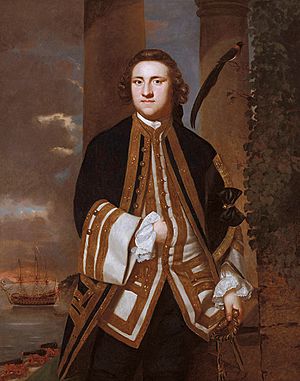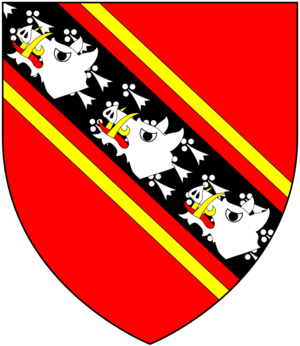George Edgcumbe, 1st Earl of Mount Edgcumbe facts for kids
Quick facts for kids
Admiral The Right Honourable
The Earl of Mount Edgcumbe
|
|
|---|---|

The Earl of Mount Edgcumbe, by Joshua Reynolds
|
|
| Member of Parliament for Fowey | |
| In office 1746–1761 Serving with Jonathan Rashleigh
William Wardour |
|
| Preceded by | Jonathan Rashleigh |
| Succeeded by | Jonathan Rashleigh Robert Walsingham |
| Member of Parliament for Plympton Erle | |
| In office 1747–1747 Serving with Richard Edgcumbe
|
|
| Preceded by | Richard Edgcumbe The Lord Sundon |
| Succeeded by | William Baker George Treby |
| Personal details | |
| Born |
George Edgcumbe
3 March 1720 |
| Died | 4 February 1795 (aged 74) |
| Spouses |
Emma Gilbert
(m. 1761) |
| Children | Richard Edgcumbe, 2nd Earl of Mount Edgcumbe |
| Parents | Richard Edgcumbe, 1st Baron Edgcumbe Matilda Furnese |
| Education | Eton College |
| Military service | |
| Allegiance | |
| Branch/service | |
| Rank | Admiral |
| Commands | Plymouth Command |
| Battles/wars | Seven Years' War |
George Edgcumbe, 1st Earl of Mount Edgcumbe (born March 3, 1720 – died February 4, 1795) was an important British figure. He was a peer (a noble), a skilled naval officer, and a politician.
Contents
Early Life and Education
George Edgcumbe was the second son of Richard Edgcumbe, 1st Baron Edgcumbe and his wife, Matilda. It is believed he went to Eton College, a famous school in England.
George Edgcumbe joined the Royal Navy in 1739 as a lieutenant. This was his first step in a long and successful career at sea.
Early Commands
In 1742, he was promoted to commander of the ship HMS Terrible. The next year, he became acting captain of the 20-gun HMS Kennington. He was officially confirmed as captain in August 1744. He sailed the Kennington in the Mediterranean Sea until 1745.
After that, he moved to the 50-gun HMS Salisbury. This ship was part of the Western Fleet, which patrolled the Bay of Biscay. This was during the War of the Austrian Succession, a big conflict in Europe.
Scurvy Experiments
While on the Salisbury in 1747, the ship's surgeon, James Lind, conducted important experiments. He was trying to find a cure for scurvy, a terrible disease that affected sailors. His work helped discover that citrus fruits could prevent scurvy. The war ended in 1748. Around this time, George Edgcumbe had his portrait painted by the famous artist Sir Joshua Reynolds.
Major Battles and Promotions
In 1751, Edgcumbe returned to the Mediterranean as a senior officer. He was in command of HMS Monmouth, and then the 50-gun HMS Deptford the following year.
In 1756, while he was still on the Deptford near Menorca, the French army invaded the island. Edgcumbe quickly sent his marines and many sailors ashore to help. He then sailed his ship to Gibraltar before the French could block the harbor.
At Gibraltar, he joined Admiral John Byng. Edgcumbe was then ordered to command the 66-gun HMS Lancaster. In the Battle of Minorca on May 20, the Lancaster was one of the ships that fought bravely.
In 1758, still on the Lancaster, he was part of the fleet that captured Louisbourg in North America. When he returned to England with the news of this victory, he was given command of the 74-gun HMS Hero. On this ship, he helped blockade the French port of Brest in 1759. He also took part in the important Battle of Quiberon Bay in November 1759, a major British victory.
He continued to serve on the Hero until his brother, Richard, died in 1761. George then inherited his brother's title and became the new Baron Edgcumbe. He also took over Mount Edgcumbe House and became the Lord Lieutenant of Cornwall. He was promoted to Rear Admiral in 1762 and then to full Admiral in 1778.
Political Career
Besides his naval career, George Edgcumbe also served in politics.
Member of Parliament
In 1746, he became a Member of Parliament for Fowey. He was considered a supporter of the government, but he was often at sea, so he didn't attend Parliament very much.
Other Political Roles
He held several other important political positions:
- He was appointed Treasurer of the Household in 1765.
- He became a Privy Councillor in 1766. This meant he advised the King.
- He was the Commander-in-Chief, Plymouth from 1766 to 1771, overseeing the naval base at Plymouth.
- In 1770, he became a vice-admiral and was appointed joint Vice-Treasurer of Ireland.
- He was also the Captain of the Honourable Corps of Gentlemen-at-Arms from 1772 to 1782.
- In 1784, he was again joint Vice-Treasurer of Ireland.
Titles and Honors
George Edgcumbe received several noble titles during his life:
- In 1781, he was made Viscount Mount Edgcumbe and Valletort.
- In 1784, he became a fellow of the Royal Society, a group of important scientists.
- In 1789, he was given the even higher title of Earl of Mount Edgcumbe.
Personal Life
On August 16, 1761, George Edgcumbe married Emma Gilbert. She was the only daughter of John VII Gilbert, who was the Archbishop of York. They had one child:
- Richard Edgcumbe, 2nd Earl of Mount Edgcumbe (1764–1839). Richard later married Lady Sophia Hobart.
Lord Mount Edgcumbe passed away on February 4, 1795. His only son, Richard, inherited his titles.
Legacy and Folklore
George Edgcumbe's wife, Emma, is part of a famous local story in English folklore called the "Lady with the Ring". A small building on the Mount Edgcumbe estate, called Lady Emma's Cottage, is named after her.
The town of Edgecomb, Maine in the United States was named after George Edgcumbe. This was because he supported the American colonists during the American Revolution.
Images for kids



